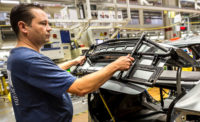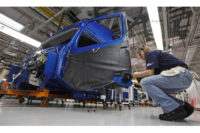Although headquartered in Gothenburg, Sweden, the Volvo Group manufactures nearly all of its engines at factories in Skovde, Sweden; Hagerstown, MD; and Lyon, France. The Lyon facility produces various types and sizes of engines for Volvo and
Renault trucks.
Last fall, increased production at the plant forced the equipment design team there to find a way produce certain metal production tools much quicker than the traditional 36 days. These tools include durable yet lightweight clamps, jigs, supports and ergonomically designed tool holders that ensure a more organized working environment for operators.
After the design team looked into 3D printing to meet this challenge, Volvo Trucks purchased a Fortus 3D production system from Stratasys Inc. It was in operation before year’s end.
“3D printing has made an incredible impact on the way we work,” explains Pierre Jenny, manufacturing director for Volvo Trucks. “The capability to produce a virtually unlimited range of functional tools in such a short timeframe enables us to be more experimental and inventive to improve workflow.”
According to Jenny, the 3D system enables Volvo Trucks to design and manufacture a tool made of production-grade thermoplastic in just two days—a 94 percent time savings compared to the old method. The system also eliminates material waste from last-minute design changes before tools are made.
“[Although] the design specifications of a metal tool were [rarely] inaccurate, the [re]design and manufacturing process was lengthy and costly,” notes Jean-Marc Robin, technical manager for Volvo Trucks. “With a 3D printed part, we simply alter the design specifications and reprint the piece in a few hours. So far, every [printed] piece has proven to be 100 percent fit-for-purpose. This instills trust among operators and quashes any traditional notion that everything has to be made from metal in order to function properly.”
Robin says the flexibility of additive manufacturing has enabled Volvo Trucks to print more than 30 types of production tools during the system’s first three months of operation. Another important benefit is improved communication between machine operators and the design team.
Operators frequently ask the team to develop a custom clamp or support tool that resolves a specific production-line problem they might be having. This interaction was unimaginable with traditional metal-tool-making techniques.
Finally, 3D printing is very cost-effective. Jenny estimates that, where customized or small quantities of tools are required, the all-in cost of 3D printing with production-grade thermoplastic (including ABSplus) is often as low as $1.13 per 0.06 cubic inch. To make the same item from metal costs approximately 100 times as much: $113 per 0.06 cubic inch.
For more information on 3D printers, call 877-489-9449 or visit www.stratasys.com.





